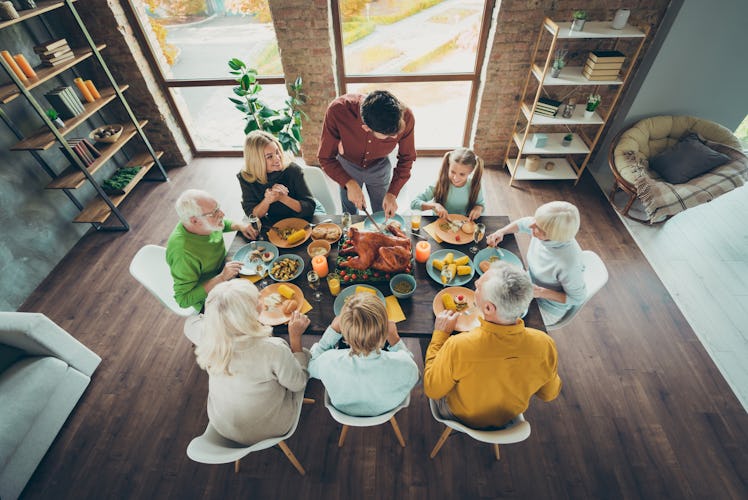
Experts Explain Why It's Best To Cut Down The Guest List This Thanksgiving
One of the biggest challenges of hosting a Thanksgiving celebration during a pandemic is the guest list. Unlike in years past when you might’ve belonged to "the more, the merrier" camp, holiday hosts will be faced with the prospect of cutting members of their family and friends from the guest list. It's a tough call, and as you prepare, you might be wondering how many people you should invite for Thanksgiving.
While all the ups and downs of 2020 might make you want to gather with friends and family during the holidays even more than usual, it's important to remember due to spiking coronavirus numbers as of Nov. 19, getting together during Thanksgiving does come with significant risk. Guidance from the U.S. Centers for Disease Control and Prevention (CDC) as of Nov. 19 states, "The safest way to celebrate Thanksgiving is to celebrate at home with the people you live with." You can keep up with the most up-to-date holiday guidance on the CDC website.
Dr. Michelle Barron, M.D., senior medical director for infection prevention and control at UCHealth, tells Elite Daily there's no safe way to hold a traditional in-person Thanksgiving celebration, especially as dropping temperatures drive people indoors.
"I'm encouraging people to really think hard about whether this is worth it or not," she says, adding that with asymptomatic spread and people taking their masks on and off to eat, "the odds are against you." As of Nov. 19, the CDC website on holiday guidance warns gatherings with family and friends outside of your immediate household "can increase the chances of getting or spreading COVID-19 or the flu." (The CDC recommends getting your flu shot before you go to any gathering.) To help stem the spread of COVID-19, the CDC also encourages people to skip holiday travel plans this year.
If you do decide to hold a gathering, there are several things you'll want to consider to help mitigate the risks. The CDC lists the lowest risk options are a virtual celebration or a dinner with only people who live in your immediate household. As you add more people outside of your living space or community, the risk increases. Small or medium-sized gatherings outdoors with family and friends in your community carry a moderate risk, while any indoor activities with people outside of your immediate living space carry a high-risk designation.
While the CDC doesn't specify a certain number of people you can have over, many state guidelines as of Nov. 18 cap any personal gatherings at 10 people. But you'll want to check local and community regulations to see if they differ. When in doubt, Dr. Barron says to err on the side of caution.
"The smaller [the gathering], the more control you potentially have, and also the more likely you can actually physically distance [from] someone," she says. It's best to limit attendees to those in your immediate household, but if you have people from other households, you should wear face masks and ask people to quarantine 14 days before the gathering.
While colder weather can make it tempting to keep the celebration indoors, Dr. John Swartzberg, M.D., F.A.C.P., clinical professor emeritus of infectious diseases and vaccinology at Berkeley Public Health, says small indoor gatherings are one of the driving factors of coronavirus infection due to the difficulties of social distancing.
"Groups of people coming together inside is a recipe for disaster," Dr. Swartzberg notes, adding that taking off your mask indoors is "too risky" — which is presents a challenge, as people need to remove masks to eat and drink. Dr. Swartzberg suggests people opt for an outdoor gathering and use heat lamps if necessary. He recommends still wearing a mask outdoors, especially when coming into contact with people outside of your bubble. (If you must hold your celebration inside, increase ventilation as much as possible by opening windows and doors, and avoiding any enclosed spaces.)
Dr. Barron says keeping the group as small as possible and clustering guests by household can be a good strategy, although keeping everyone separate the entire party can be unrealistic. She also suggests "hav[ing] appetizers and not a full meal" in order to shorten the gathering. According to the CDC, "being within 6 feet of someone who has COVID-19 for a cumulative total of 15 minutes or more greatly increases the risk of becoming sick and requires a 14-day quarantine."
But even with all the precautionary measures, there are still risks involved. Rather than toying with the guest list, Dr. Barron suggests canceling, "or at least postpon[ing]," your Thanksgiving celebration.
"I think this might be the year you get creative, and you do your party via Zoom ... or FaceTime," she explains. "[There are] different ways to do this without putting somebody at risk."
If you think you’re showing symptoms of coronavirus, which include fever, shortness of breath, and cough, call your doctor before going to get tested. If you’re anxious about the virus’s spread in your community, visit the CDC for up-to-date information and resources, or seek out mental health support. You can find all of Elite Daily's coverage of coronavirus here.
Sources cited:
Dr. John Swartzberg, M.D., F.A.C.P., clinical professor emeritus at the UC Berkeley School of Public Health's Division of Infectious Diseases and Vaccinology
Dr. Michelle Barron, M.D., Senior medical director for infection prevention and control at UCHealth